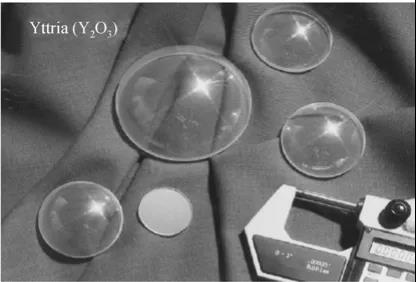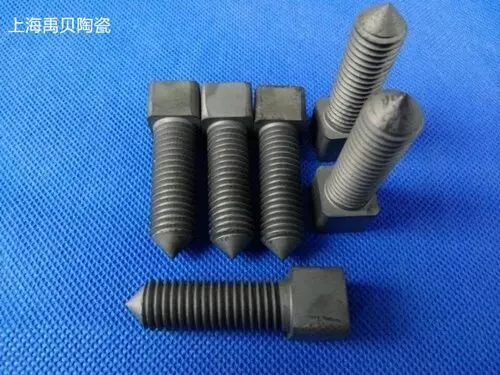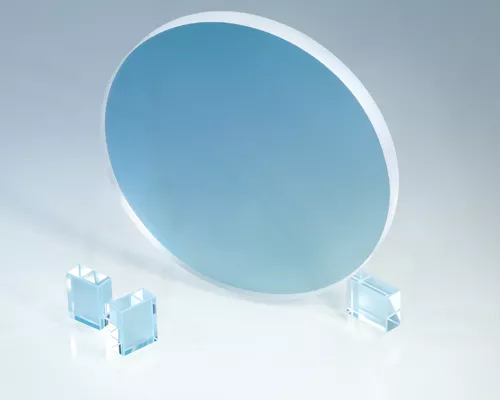Yttrium oxide (Y2O3) has a cubic structure, high melting point, good chemical and photochemical stability, a wide range of optical transparency, low phonon energy, and is easy to achieve doping with rare earth ions. It has excellent plasma resistance, making it an ideal choice for semiconductor processing equipment applications that must avoid particle contamination, as it can reduce equipment maintenance requirements and improve productivity.
Transparent yttrium oxide ceramics have excellent optical and thermal properties, and are a functional material with high application value. They have potential applications in high-temperature windows, infrared head covers, luminescent media (scintillation, laser, and upconversion luminescence), and the semiconductor industry. It has now become a substitute material for single crystals.
The main physical and chemical properties of yttrium oxide are:
1. High melting point, good chemical and photochemical stability, and a wide range of optical transparency (0.23~8.0μm).
2. At 1050nm, its refractive index is as high as 1.89, which gives it a theoretical transmittance of over 80%.
3. Yttrium oxide has effective bandgap engineering with a large bandgap that can accommodate most trivalent rare earth ion emission levels, making it versatile in its applications.
4. Low phonon energy, with a maximum phonon cutoff frequency of about 550 cm-1. Its low phonon energy can suppress the probability of non-radiative transitions and increase the probability of radiative transitions, thereby increasing luminescence efficiency.
5. High thermal conductivity, approximately 13.6 W/(m·K), is essential for its use as a solid laser cutoff material.
These characteristics make transparent yttrium oxide ceramics potentially valuable in high-temperature windows, infrared detection, luminescent media, and the semiconductor industry.
The preparation of transparent yttrium oxide ceramics mainly involves powder and sintering technology:
In terms of powders, some use commercial high-purity powders as raw materials, while others use powders synthesized by wet chemical methods or gas-phase methods.
In terms of sintering, reported methods include hot-pressed sintering, hot isostatic pressing sintering, vacuum sintering, and hydrogen atmosphere sintering (dry hydrogen, wet hydrogen). The densification mechanisms can be summarized as pure solid-phase high-temperature sintering, liquid-phase sintering/instantaneous liquid-phase sintering, pressure-assisted sintering, and solid solution activation sintering. To improve the optical quality of transparent yttrium oxide ceramics and reduce sintering temperature, multiple sintering methods are generally used in combination.
The potential applications of yttrium oxide due to its excellent physical and chemical properties include missile infrared windows and domes, visible and infrared lenses, high-pressure gas discharge lamps, ceramic scintillators, and ceramic lasers.
1. High-pressure gas discharge lamps: Yttrium oxide has a cubic crystal structure, isotropic optical properties, high chemical stability, and can withstand the corrosion of metal sodium vapor and other metal halide vapors. Its use in high-intensity gas discharge lamps has been a focus of researchers, although there are still technical and cost limitations to its practical application.
2. Window materials: Materials with good optical transmittance in the 3~5μm range have important military applications. Although researchers have successfully developed yttrium oxide transparent ceramics with good transmittance through various sintering processes in the laboratory, the optical properties of commercial nano yttrium oxide powders with high impurities currently cannot meet actual application requirements.

3. Y2O3-based scintillation ceramics: In the 1980s, researchers successfully sintered (Y, Gd)2O3:Eu,Pr transparent ceramics. Gd2O3 doping increased the density and X-ray absorption coefficient of the sample. This material, with high light output, short afterglow time, and emission peak matching the detector, has been used as a ceramic scintillator in GE Medical's X-CT, with an annual output in tons and high commercial value.
4. Upconversion luminescence of Y2O3 transparent ceramics: Y2O3, as an excellent luminescent material matrix, has long been used in fluorescent powders for lamps and electroluminescence. Studies have shown that Y2O3 has low phonon energy (500 cm-1), similar to the highly efficient upconversion ZBLAN glass (a fluoride glass with a phonon energy of 500 cm-1). Research has shown that transparent yttrium oxide ceramics doped with different rare earth ions exhibit good upconversion luminescence properties under 980nm LD excitation, achieving upconversion emissions at multiple wavelengths such as blue, green, orange, and red in the 420-680nm range.
Summary:
In essence, the preparation of transparent yttrium oxide ceramics does not differ significantly from other special ceramics, but the differences in powder raw materials and sintering processes can result in completely different optical qualities of the transparent ceramics. Compared with foreign research, domestic research on yttrium oxide is currently in the laboratory research stage, and there is still a long way to go before it can be put into mass production for civilian use and targeted for specific practical applications.
References:
"Research Progress on Yttrium Oxide Transparent Ceramics" by Lingling Jin, Zhijun Jiang, Jian Zhang, and Shiwei Wang - Journal of the Chinese Ceramic Society
"Research Progress on Y2O3 Transparent Ceramics" by Bin Lv, Ting Sun, and Yi Wang.
Declaration: This article is provided by CERADIR™ users or obtained from Internet, the content does not represent the position of CERADIR™. We are not responsible for the authenticity/accuracy of the article, especially the effects of the products concerned. This article is for study only, it does not constitute any investment or application advice. For reprinting, please contact the original author. If it involves the copyright and/or other issues, please contact us and we will deal with it asap! CERADIR™ has the interpretation of this declaration.







